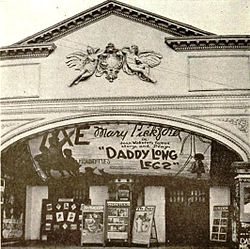|
Electra, Texas
Electra is a city in Wichita County, Texas, United States. It is part of the Wichita Falls metropolitan statistical area. The population was 2,292 at the 2020 census., down from 2,791 in 2010.[4] Electra claims the title of Pump Jack Capital of Texas, a title made official by the state in 2001,[5] and has celebrated an annual Pump Jack Festival since 2002.[6] It was named in honor of Electra Waggoner, an heiress to the Waggoner Ranch.[7] Electra is also known for its Grand Theatre which was refurbished and now a functioning theater. History Daniel Waggoner started a ranch in present-day Electra in 1852. Around 30 years later, the Fort Worth and Denver Railway was built, and its railroad tracks ran through the area. In 1885, Waggoner's son, William Thomas Waggoner, successfully lobbied railroad executives to build a railroad station at the site. By this time, the Waggoner ranch covered a half-million acres. Until this time, the town was called Waggoner, but following the building of the station and a post office in 1889, it was dubbed Beaver Switch, after the nearby Beaver Creek. The opening of 56,000 acres (230 km2) of land north of the railroad station brought more farmers to the area. The town was renamed again in 1907, this time after Waggoner's daughter, Electra Waggoner. Water can be scarce in this region of Texas, so Waggoner started drilling for water for the town's new residents. Most of these drilling sites were befouled by crude oil, which made the water unfit for drinking. Three years later, a developer from Fort Worth named Solomon Williams bought the land from Waggoner. Soon thereafter, he annexed nearby land, subdivided the land, and placed advertisements in national media trying to increase the population. His efforts were successful, and the town grew from a population of 500 to 1,000 between 1907 and 1910. The Waggoner family still owns much of the same land they did in the beginning and still drills for oil there. In 1911, the Electra Independent School District was created. On 1 April 1911, the Clayco Oil gusher brought in an oil strike at a depth of 1,600 feet (490 m), producing 260 barrels of oil per day (BOPD). Word spread quickly, and the population increased to over 1,000, with many more oil workers commuting from Wichita Falls. The town soon had brick buildings, cement sidewalks, and a telephone exchange.[8] In 1936, Electra had well over 6,000 residents, but by the 1960s, the population had decreased to just over 5,000. The Dallas-Fort Worth Metroplex was growing, and many people moved away. By 2000, Electra's population had fallen to about 3,000. GeographyAccording to the United States Census Bureau, the city has a total area of 2.4 mi2 (6.3 km2), all land. ClimateThe climate in this area is characterized by hot, humid summers and generally mild to cool winters. According to the Köppen climate classification system, Electra has a humid subtropical climate, Cfa on climate maps.[9] Demographics
As of the 2020 United States census, there were 2,292 people, 1,253 households, and 606 families residing in the city. EducationThe City of Electra is served by the Electra Independent School District, which is composed of 210 sq mi (540 km2). The three public schools are: B.M. Dinsmore Elementary School, with 225 students enrolled in prekindergarten through fourth grade; Electra Junior High with 172 students in grades five through eight; and Electra High School with 149 students enrolled in ninth through 12th grades. Electra High School's athletic teams are called the Tigers. The student/teacher ratio at each of the schools is 14:1, 13:1, and 9:1, respectively. Notable Persons
Utilities
References
Further reading
External linksWikimedia Commons has media related to Electra, Texas.
|
|||||||||||||||||||||||||||||||||||||||||||||||||||||||||||||||||||||||||||||||||||||||||||||||||||||||||||||||||||||||||||||||||||||



